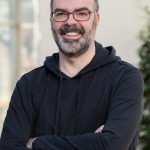It became very clear that a solid mathematical and scientific education is a must for these disciplines, especially when it comes to statistics. And with the increasing amount of big medical data, statisticians had to become data scientists and keep expanding their competencies along the way. So, it comes with no surprise that there already is an association of those specialists to benefit from each other’s knowledge – called “PHUSE."
PHUSE is an independent, nonprofit global community and platform started in 2004 for the discussion of topics encompassing the work of data managers, biostatisticians, statistical programmers, data scientists and eClinical IT professionals in the biopharmaceutical industries and life sciences organizations.
In parallel, SAS has a long history in the global life science industry. Medical statistical programmers very often learn SAS as their “common language” to report on the efficiency and safety of new drugs to the authorities. Since there were two PHUSE events just recently (both virtually: EU Connect 2020 on Nov. 9-13 and PHUSE Germany on Dec. 1), we took the chance to remember a little bit of this great history of joint collaboration. And we asked Dr Mark Lambrecht, Director of the Global Health and Life Sciences Practice at SAS, about the beginnings of PHUSE.
Mark, do you remember when PHUSE actually started to lift off?
Oh, yes, I remember that very well. The first conference was organized in 2005, my first year at SAS, and it was in Heidelberg. A group of future-looking biostatisticians and clinical data managers set up PHUSE and organized a first discussion forum to advance efficient programming techniques and speed up clinical development efforts. As some SAS employees like David Smith from our UK office were part of that group, we offered a place to meet and some support to get things going. Since then, SAS has been a proud sponsor of this community that has grown spectacularly and is a great success.
So you were there, in person? In Heidelberg?
Yes, I am proud to say that I was there. And it was fascinating. This was before pharmaceutical companies started talking about “precompetitive collaboration,” and this group of people from different pharmaceutical companies, scientific institutes and technology vendors had the foresight that working together might help everyone. Nowadays the benefits of these type of knowledge exchanges are abundantly clear, but it wasn’t at the time, even though there was a need.
I am a strong believer in industry users independently organizing these events themselves and SAS providing the support where possible and appropriate. Back in 2005, there was a lot of sharing of tips and tricks. And everything that PHUSE does today has been conceived by that initial group of people, mostly from the UK and Germany. They are still part of the core leadership team of PHUSE. And look at where it is now. PHUSE has grown to over 10,000 global members meeting regularly.
What was the role of SAS at that time?
Well, because of its unique capabilities, SAS has helped pharmaceutical companies to manage and analyze clinical trial data since the company started in 1976. SAS has been a de facto standard for a lot of the trial submission work involved in getting new therapies approved. In addition to powerful data management and analytical technology, we also developed the first standard data format, called SAS transport v5 files – these have been donated to the public domain since the early 1990s.
In 2005 when PHUSE held their first annual conference, CDISC had just developed its first standards specifications a few years before, and SAS supported and contributed to those standards. Just like today, every pharmaceutical sponsor was using SAS back then – and integrating it with an ever-evolving technology stack. In that sense, nothing really changed.
What did change over time, and how is the situation today?
I remember technologies like Java, new forms of web reporting such as CGI and web services were quite important then as clinicians and nonprogrammers needed more access to the trial information. Not all of this tech stack has survived – some have. Today SAS will coexist with technologies like R, Python, and cloud-native technologies. Then, just as now, SAS was the constant factor that allowed developers to be effective and glue together different data pipelines on regulated technology environments.
What has changed is that pharmaceutical data and statistical designs of trials are getting more complex, and users are expanding their skill sets and becoming more versatile. PHUSE users are rightly rebranding themselves as data scientists, reflecting the need to work in different settings with different external and internal user profiles. They work with different types of data such as images, genomics, sensors and wearables and various analytical approaches.
SAS has evolved, too, as a cloud-native data science platform, allowing users to work with streaming data, in-memory big data analytics, more modern interfaces and open source technology even built into our solutions. This technology revolution coincides with enormous advancements in therapeutic science – delivering genetic cures rather than therapies to patients. Pharmaceutical programmers are required to constantly upgrade their skills. I predict that in five to 10 more years, SAS will be part of a lot of digital health care solutions, as Software-as-a-Medical-Device (SaMD), with the clinician relying on SAS to make therapeutic decisions in real time. If you would have told me that 15 years ago, I might not have believed you!
What happened during the coronavirus pandemic? What was the role of SAS there?
We had seen the pandemic arriving in Europe and the USA early in the year, as we worked together closely with our Asian colleagues. Together with some other leaders in the company, we proposed to our executive team to pull together a global COVID-19 response interdisciplinary team to help out hospitals, health care government agencies, pharmaceutical companies and other essential organizations, such as food companies.

I have had the pleasure to work together with many smart colleagues at SAS this year to help out customers. From leading epidemiological modelling teams helping governments understand what was happening, to medical resource optimization for hospitals, to forecasting the impact on supply chains for food companies, this has been a whirlwind year for me. We published a widely used epidemiological dashboard to allow users to understand the pandemic status. We offered free environments to allow users to combine this data with their organizational data for planning purposes, published all code in GitHub, and created a text analytics environment to find relevant COVID-19 scientific studies. And we developed a whole series of use cases, products and technology marketed globally to do analytical contact tracing, intensive care unit monitoring and a lot more!
I was most impressed by how epidemiologists, analytical experts, architects, programmers and others are working together, both within SAS and between organizations to get things done in record times. I am honoured to lead teams that collaborate, have the skills and talents to push the needle and make a difference for society at a time of need. And we did most of this in a philanthropic mode.
Now, back to PHUSE. Did this community react specifically to COVID-19 as well?
Oh, yes! The trustful connections they built over years ended up in a very lively exchange on all kinds of challenges around the pandemic. PHUSE has best practices on such subjects as the impact for clinical trial data transparency of COVID-19. The annual PHUSE EU Connect had many presentations on how to deal with the impact of COVID-19 on clinical trials. Being part of this community, we look forward to continuing to work with PHUSE to help achieve its ongoing goal: a true knowledge community to help clinical programmers and data scientists. And all along serving the real reason why we are all in this industry – to bring innovative therapies that help the patient, or as demonstrated today, protect citizens against infectious diseases.
